《固体物理学》课程教学课件(PPT讲稿)Chapter 4 lattice dynamics and lattice capacity 4.6 Anharmonic Effects 4.7 Equation of states for Lattice 4.8 Experimental methods for the determinations of lattice vibration spectroscopy
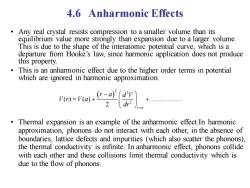
4.6 Anharmonic Effects Any real crystal resists compression to a smaller volume than its equilibrium value more strongly than expansion due to a larger volume. This is due to the shape of the interatomic potential curve,which is a departure from Hooke's law,since harmonic application does not produce this property. This is an anharmonic effect due to the higher order terms in potential which are ignored in harmonic approximation. o=ra+-a() Thermal expansion is an example of the anharmonic effect.In harmonic approximation,phonons do not interact with each other,in the absence of boundaries,lattice defects and impurities (which also scatter the phonons), the thermal conductivity is infinite.In anharmonic effect,phonons collide with each other and these collisions limit thermal conductivity which is due to the flow of phonons
4.6 Anharmonic Effects • Any real crystal resists compression to a smaller volume than its equilibrium value more strongly than expansion due to a larger volume. This is due to the shape of the interatomic potential curve, which is a departure from Hooke’s law, since harmonic application does not produce this property. • This is an anharmonic effect due to the higher order terms in potential which are ignored in harmonic approximation. • Thermal expansion is an example of the anharmonic effect.In harmonic approximation, phonons do not interact with each other, in the absence of boundaries, lattice defects and impurities (which also scatter the phonons), the thermal conductivity is infinite. In anharmonic effect, phonons collide with each other and these collisions limit thermal conductivity which is due to the flow of phonons.( ) 2 2 2 ( ) ( ) . 2 r a r a d V V r V a dr = − = + +

4.6.1 Phonon-phonon collisions The coupling of normal modes by the unharmonic terms in the interatomic forces can be pictured as collisions between the phonons associated with the modes.A typical collision process of phononl 03,k3 After collision another phonon is produced 2,k2 phonon2 o3=01+02andk3=k+k2 ho,=ho,+hw2→ conservation of energy hks =hk +hk conservation of momentum
4.6.1 Phonon-phonon collisions The coupling of normal modes by the unharmonic terms in the interatomic forces can be pictured as collisions between the phonons associated with the modes. A typical collision process of phonon1 phonon2 1 1 , k 2 2 , k 3 3 , k After collision another phonon is produced 3 1 2 k k k = + 3 1 2 k k k = + 3 1 2 = + 3 1 2 = + and conservation of energy conservation of momentum
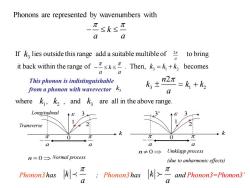
Phonons are represented by wavenumbers with -亚≤k -and Phonon3=Phonon3' a
Phonon3 has k a ; Phonon3 has k and Phonon3=Phonon3’ a 1 2 k a − 0 a 3' Umklapp process (due to anharmonic effects) 3 1 2 k a − 0 a Normal process Longitudinal 3 Transverse n = 0 n 0 Phonons are represented by wavenumbers with k a a − If lies outside this range add a suitable multible of to bring it back within the range of . Then, becomes 3 k 3 1 2 n2 k k k a = + where , , and are all in the above range. 2 a 3 1 2 k k k k = + a a − 2 k 3 k 1 k This phonon is indistinguishable from a phonon with wavevector 3 k
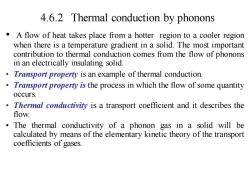
4.6.2 Thermal conduction by phonons A flow of heat takes place from a hotter region to a cooler region when there is a temperature gradient in a solid.The most important contribution to thermal conduction comes from the flow of phonons in an electrically insulating solid. Transport property is an example of thermal conduction. 。 Transport property is the process in which the flow of some quantity occurs. Thermal conductivity is a transport coefficient and it describes the flow. The thermal conductivity of a phonon gas in a solid will be calculated by means of the elementary kinetic theory of the transport coefficients of gases
4.6.2 Thermal conduction by phonons • A flow of heat takes place from a hotter region to a cooler region when there is a temperature gradient in a solid. The most important contribution to thermal conduction comes from the flow of phonons in an electrically insulating solid. • Transport property is an example of thermal conduction. • Transport property is the process in which the flow of some quantity occurs. • Thermal conductivity is a transport coefficient and it describes the flow. • The thermal conductivity of a phonon gas in a solid will be calculated by means of the elementary kinetic theory of the transport coefficients of gases

In the elementary kinetic theory of gases,the steady state flux P of a property in the z direction is =118 dp z Angular average Mean free path Constant average speed for molecules In the simplest case where P is the number density of particles the transport coefficient obtained from above q n.is the diffusion coefficient If P is the energy density E then the flux,W is the heat flow per unit area so that m=ln-=l元aedr 3 dz 3 dT dz Now dE/dT is the specific heat c per unit volume,so that the thermal conductivity; K- 1C Works well for a phonon gas 3
In the elementary kinetic theory of gases, the steady state flux of a property in the z direction is P _ 1 3 dP flux l dz = Mean free path Angular average Constant average speed for molecules In the simplest case where is the number density of particles the transport coefficient obtained from above eq n. is the diffusion coefficient . If is the energy density then the flux, W is the heat flow per unit area so that _ _ 1 1 3 3 dE dE dT W l l dz dT dz = = Now is the specific heat per unit volume, so that the thermal conductivity; 1 _ 3 K l C = P 1 _ 3 D l = P E dE dT / C Works well for a phonon gas

Heat conduction in a phonon and real gas The essential differences between the processes of heat conduction in a phonon and real gas; Phonon gas Real gas .No flow of particles .Speed is approximately constant. .Average velocity and kinetic energy .Both the number density and energy per particle are greater at the hot end, density is greater at the hot end. but the number density is greater at the cold end,and the energy density is .Heat flow is primarily due to uniform due to the uniform pressure. phonon flow with phonons being created at the hot end and destroyed .Heat flow is solely by transfer of at the cold end kinetic energy from one particle to another in collisions which is a minor effect in phononcase. hot cold hot cold
Heat conduction in a phonon and real gas The essential differences between the processes of heat conduction in a phonon and real gas; Phonon gas Real gas •Speed is approximately constant. •Both the number density and energy density is greater at the hot end. •Heat flow is primarily due to phonon flow with phonons being created at the hot end and destroyed at the cold end •No flow of particles •Average velocity and kinetic energy per particle are greater at the hot end, but the number density is greater at the cold end, and the energy density is uniform due to the uniform pressure. •Heat flow is solely by transfer of kinetic energy from one particle to another in collisions which is a minor effect in phonon case. hot cold hot cold
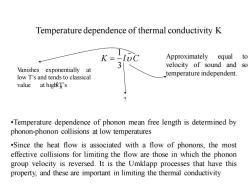
Temperature dependence of thermal conductivity K K Approximately equal to 3 velocity of sound and so Vanishes exponentially at temperature independent. low T's and tends to classical value at higlT's .Temperature dependence of phonon mean free length is determined by phonon-phonon collisions at low temperatures .Since the heat flow is associated with a flow of phonons,the most effective collisions for limiting the flow are those in which the phonon group velocity is reversed.It is the Umklapp processes that have this property,and these are important in limiting the thermal conductivity
Temperature dependence of thermal conductivity K _ 1 3 K l C = Approximately equal to velocity of sound and so temperature independent. Vanishes exponentially at low T’s and tends to classical value at high T’s B k ? •Temperature dependence of phonon mean free length is determined by phonon-phonon collisions at low temperatures •Since the heat flow is associated with a flow of phonons, the most effective collisions for limiting the flow are those in which the phonon group velocity is reversed. It is the Umklapp processes that have this property, and these are important in limiting the thermal conductivity
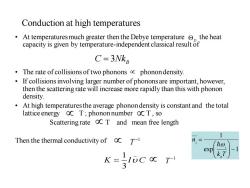
Conduction at high temperatures At temperatures much greater then the Debye temperature the heat capacity is given by temperature-independent classical result of C=3Nkg The rate of collisions of two phonons oc phonondensity. If collisions involving larger number of phonons are important,however, then the scattering rate will increase more rapidly than this with phonon density. At high temperatures the average phonon density is constant and the total lattice energy oc T;phononnumber oCT,so Scattering rate C T and mean free length Then the thermal conductivity of Oc T- ho exp T K=T- 3
Conduction at high temperatures • At temperatures much greater then the Debye temperature the heat capacity is given by temperature-independent classical result of • The rate of collisions of two phonons phonon density. • If collisions involving larger number of phonons are important, however, then the scattering rate will increase more rapidly than this with phonon density. • At high temperatures the average phonon density is constant and the total lattice energy T ; phonon number T , so Scattering rate T and mean free length Then the thermal conductivity of . 1 T − D 3 C Nk = B _ 1 3 K l C = 1 T − exp 1 1 − = k T n B j j

Experimental results do tend towards this behaviour at high temperatures as shown in figure (a). 10 10 0 0 T 10- T3 101 5102050100 25102050100 T(K) T(K) (a)Thermal conductivity of a quartz (b)Thermal conductivity of artificial crystal sapphire rods of different diameters
• Experimental results do tend towards this behaviour at high temperatures as shown in figure (a). 1 T 5 10 20 50 100 10 0 10-1 T K( ) 2 5 10 20 50 100 T K( ) 10 0 10-1 3 T (a)Thermal conductivity of a quartz crystal (b)Thermal conductivity of artificial sapphire rods of different diameters

Conduction at low temperatures for phonon-phonon collisions becomes very long at low T's and eventually exceeds the size ofthe solid,because number of high energy phonons necessary for Umklapp processes decay exponentially as elbr is then limited by collisions with the specimen surface,i.e. I o Specimen diameter TdependenceofK comes fromC which obeys T law in this region Temperature dependence of C dominates. 5
Conduction at low temperatures for phonon-phonon collisions becomes very long at low T’s and eventually exceeds the size of the solid, because number of high energy phonons necessary for Umklapp processes decay exponentially as is then limited by collisions with the specimen surface, i.e. Specimen diameter T dependence of K comes from which obeys law in this region Temperature dependence of dominates. l / D bT e − 3 T l l Cv 3 4 12 5 B D D Nk T C Cv
按次数下载不扣除下载券;
注册用户24小时内重复下载只扣除一次;
顺序:VIP每日次数-->可用次数-->下载券;
- 《固体物理学》课程教学课件(PPT讲稿)Chapter 5 band theory 5.1 general background and approximations 5.2 Bloch’s Theorem.ppt
- 《固体物理学》课程教学课件(PPT讲稿)Chapter 4 lattice dynamics and lattice capacity 4.5 Heat capacity of the lattice.ppt
- 《固体物理学》课程教学课件(PPT讲稿)Chapter 4 lattice dynamics and lattice capacity 4.1 Normal Modes of Vibration 4.2 Density of States 4.3 Harmonic approximation and normal mode coordinates 4.4 phonon.ppt
- 《固体物理学》课程教学课件(PPT讲稿)Chapter 3 Interatomic Bonding 3.1 General crystal binding 3.2 typical binding.ppt
- 《固体物理学》课程教学课件(PPT讲稿)Chapter 3 Interatomic Bonding 3(Supplement - Rules of crystal binding).ppt
- 《固体物理学》课程教学课件(PPT讲稿)Chapter 3 Interatomic Bonding 3.3 The cohesive energy for ionic crystal.ppt
- 《固体物理学》课程教学课件(PPT讲稿)Chapter 2 Wave Diffraction & the Reciprocal Lattice(2.1-2.5).ppt
- 《固体物理学》课程教学课件(PPT讲稿)Chapter 2 Wave Diffraction & the Reciprocal Lattice 2.6 X-Ray Diffraction Methods 2.7 Applications of XRD.ppt
- 《固体物理学》课程教学课件(PPT讲稿)Chapter 2 Wave Diffraction & the Reciprocal Lattice(supplement - Review & Overview of X-Rays).ppt
- 《固体物理学》课程教学课件(PPT讲稿)Chapter 1 Crystal Structure 1.9 Elements of Symmetry 1.10 Space groups 1.11 7 crystal system and 14 Bravis Lattice.ppt
- 《固体物理学》课程教学课件(PPT讲稿)Chapter 1 Crystal Structure(Supplement - microstructure and crystal system).ppt
- 《固体物理学》课程教学课件(PPT讲稿)Introduction.ppt
- 《固体物理学》课程教学课件(PPT讲稿)Chapter 1 Crystal Structure 1.1 Elementary Crystallography 1.2 Crystal Structure ≡ Lattice + Basis 1.3 Lattice Translation Vectors 1.4 Non-Bravais Lattices 1.5 Wigner-Seitz Method.ppt
- 《固体物理学》课程教学课件(PPT讲稿)Chapter 1 Crystal Structure 1.6 typical crystal structure.ppt
- 《固体物理学》课程教学课件(PPT讲稿)Chapter 1 Crystal Structure 1.7 Lattice Sites in a Cubic Unit Cell 1.8 crystal plane and miller index.ppt
- 《固体物理学》课程教学资源(参考资料)词汇汉英对照.pdf
- 《固体物理学》课程授课教案(讲义)第五章 能带理论.pdf
- 《固体物理学》课程授课教案(讲义)第一章 晶体结构.pdf
- 《固体物理学》课程授课教案(讲义)第三章 晶体的结合.pdf
- 《固体物理学》课程授课教案(讲义)第四章 晶格振动.pdf
- 《固体物理学》课程教学课件(PPT讲稿)Chapter 4 lattice dynamics and lattice capacity 4(supplement - Thermal Expansion of Glass).ppt
- 《固体物理学》课程教学课件(PPT讲稿)Chapter 5 band theory 5.5 The symmetry of bands.ppt
- 《固体物理学》课程教学课件(PPT讲稿)Chapter 5 band theory 5.3 Nearly Free Electron 5.4 BZ and energy bands.ppt
- 《固体物理学》课程教学课件(PPT讲稿)Chapter 5 band theory 5.4 Tight Binding Approximation(TBA).ppt
- 《固体物理学》课程教学课件(PPT讲稿)Chapter 6 Electron motion in the crystal 6.1 The quasi-classical description of Bloch electrons 6.2. Electron quasi-momentum 6.3 The accelerated velocity and effective mass.ppt
- 《固体物理学》课程教学课件(PPT讲稿)Chapter 6 Electron motion in the crystal 6(supplement - a more concise description of quasi-momentum).ppt
- 《固体物理学》课程教学课件(PPT讲稿)Chapter 6 Electron motion in the crystal 6.4 The electron motion in a constant electric field 6.5 Band structure of conductor, insulator and semiconductor.ppt
- 《固体物理学》课程教学课件(PPT讲稿)Chapter 7 The electronic theory of metal(supplement - Sommerfield expansion).ppt
- 《固体物理学》课程教学课件(PPT讲稿)Chapter 7 The electronic theory of metal 7.1 Fermi statistics and the heat capacity of electron 7.2 Work function and contact potential.ppt
- 《固体物理学》课程教学课件(PPT讲稿)Chapter 5 band theory 5.6 Density of states(DOS)and Fermi surface 5.7 the electrons in the crystal 5.8 the experimental results for DOS.ppt
- 《近代物理实验》课程教学大纲.doc
- 《近代物理实验》课程教学资源(PPT课件讲稿,共五部分).ppt
- 《工程光学》课程教学大纲 Engineering Optics.doc
- 安徽大学:《工程光学》课程授课教案(讲义,共十三章,授课教师:李桂华).doc
- 《工程光学》课程实验指导书(共六个实验).doc
- 《量子力学》课程教学课件(讲稿)Chapter 4 态和力学量的表象 The representation for the states and dynamical variable.pdf
- 《量子力学》课程教学课件(讲稿)Chapter 1 绪论 Quantum mechanism(量子力学的诞生).pdf
- 《量子力学》课程教学课件(讲稿)Chapter 2 波函数和薛定谔方程 The wave function and Schrödinger Equation.pdf
- 《量子力学》课程教学课件(讲稿)Chapter 3 量子力学中的力学量 The Dynamical variable in Quantum Mechanism.pdf
- 《量子力学》课程教学课件(讲稿)Chapter 6 散射 Scattering.pdf
